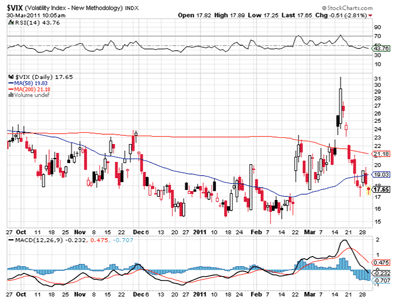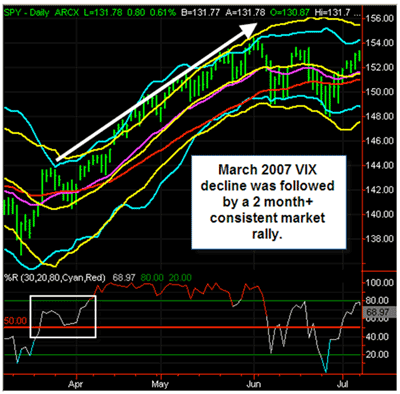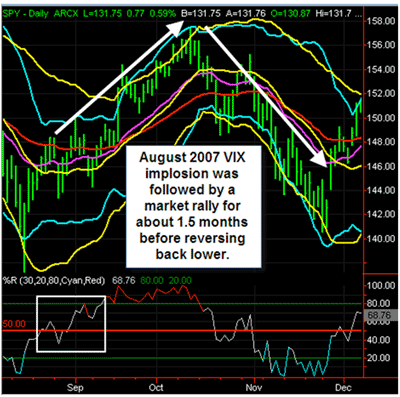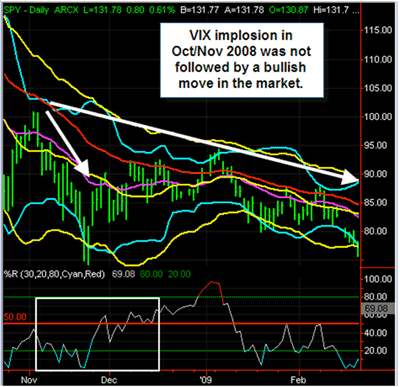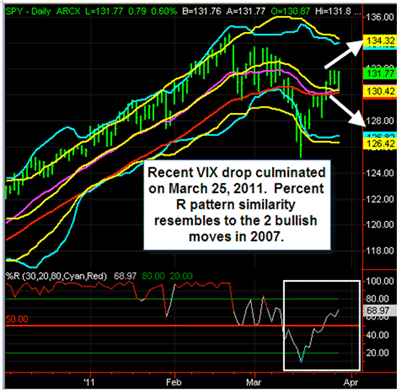The huge recent plunge in the VIX has been equaled only a few times in recent years, but we can refer to past occurrences to predict whether the markets may head higher or lower from here.
In a meeting this week with other option traders, one of the major points of discussion brought up by Price Headley from BigTrends.com and the other portfolio managers was the huge decline seen recently in the CBOE Volatility Index, as represented by:
- Volatility Index (VIX)
- Barclays/iPath S&P 500 VIX Short-Term Futures ETN (VXX)
- Barclays/iPath S&P 500 VIX Mid-Term Futures ETN (VXZ)
The VIX dropped from an intraday high of 31.28 on March 16 to an intraday low of 17.07 on March 25. Such a rapid plunge/implosion in the VIX occurs rarely, in our experience.
So we decided to look back at previous data to see how the market performs following such a sharp drop in this measure of index option implied volatility (and a good measure of sentiment among option traders).
The VIX data used was from the CBOE Web site and covers 2004 to the present.
The recent VIX drop measured over 45% in decline from peak to trough, and that is certainly a rare occurrence during this seven-year time frame.
The only other occurrences of a 40%+ drop in the VIX over eight trading days were in March 2007, August 2007, and October/November 2008. How did the market react following similar VIX plunges? Take a look at the charts below.
Taking a look at the S&P 500 Index (SPY) in March 2007 following the VIX plunge, you can see below that we had a steady, two-month-plus rally in the markets.
Also note that our smoothed Williams percent range (%R) reading (bottom of the chart) broke above the 50 mid-level following this signal and quickly moved into strongly bullish territory, indicating overall market strength of trend.
Here is a daily chart of SPY performance following the March 2007 VIX drop:
The next occurrence was in August 2007 (see chart below). In this case, the market also rallied nicely in the daily trend, following the signal, however, in this case, the rally petered out after about 1.5 months and subsequently reversed lower. Note again here a similar upward move in %R that, although a bit more “whippy,” did show some strength.
Here is a daily chart of the SPY performance following the August 2007 VIX drop:
NEXT: Examine the Most Recent Similar Occurrence
|pagebreak|The most recent similar pattern was in October/November 2008. In this case, we saw a very different market reaction to a short-term VIX implosion. The market sold off fairly sharply in the two weeks following this event, and in general drifted lower on a less-sharp trajectory over the next several months.
We then had the famous culminating panic bottom of March 2009. Note here that %R did not move above the 50 mid-level following this VIX move and basically stayed below or around mid-levels for some time.
Here is a daily chart of SPY performance following the October/November 2008 VIX drop:
Now we come to the current market situation, with the VIX implosion only having occurred a couple of trading days ago.
What will be the move this time around? Well, there are not a lot of historical examples to compare, so this is a very unusual circumstance, but based on the steady move higher seen in %R, we would anticipate that the market will react similar to the two moves in 2007, making a net-positive move over the next one to two months likely.
Here is a current SPY chart:
Bottom line: The giant drop in option implied volatility seen in recent weeks is unusual in terms of the scope of the VIX plunge. Keep an eye on %R and other momentum/trend indicators, as we seem likely to rally in the coming weeks should we hold above mid-levels on this indicator.
By Moby Waller, co-portfolio manager, BigTrends.com
